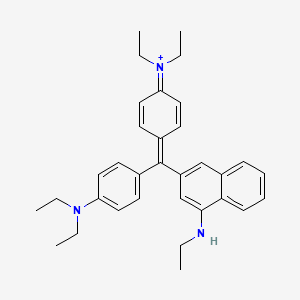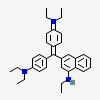Cascade Blue
- Cascade blue
- CHEBI:51932
- N-(4-{[4-(diethylamino)phenyl][4-(ethylamino)-2-naphthyl]methylene}cyclohexa-2,5-dien-1-ylidene)-N-ethylethanaminium
- 500906-09-2
- N-(4-((4-(diethylamino)phenyl)(4-(ethylamino)-2-naphthyl)methylene)cyclohexa-2,5-dien-1-ylidene)-N-ethylethanaminium
- Create:2005-08-08
- Modify:2025-01-18

- Cascade blue
- CHEBI:51932
- N-(4-{[4-(diethylamino)phenyl][4-(ethylamino)-2-naphthyl]methylene}cyclohexa-2,5-dien-1-ylidene)-N-ethylethanaminium
- 500906-09-2
- N-(4-((4-(diethylamino)phenyl)(4-(ethylamino)-2-naphthyl)methylene)cyclohexa-2,5-dien-1-ylidene)-N-ethylethanaminium
- 12238-23-2
- SCHEMBL15746731
- DTXSID10924147
- [4-[[4-(diethylamino)phenyl]-[4-(ethylamino)naphthalen-2-yl]methylidene]cyclohexa-2,5-dien-1-ylidene]-diethylazanium
- 61725-40-4
- DB-215383
- Q27122998
- [4-[(4-Diethylaminophenyl)-(4-ethylaminonaphthalen-2-yl)methylidene]-1-cyclohexa-2,5-dienylidene]-diethyl-azanium
- 4-{[4-(Diethylamino)phenyl][4-(ethylamino)-2-naphthyl]methylene}-N,N-diethylcyclohexa-2,5-dien-1-iminium
Pulp and Paper Processing [Category: Industry]
Painting (Pigments, Binders, and Biocides) [Category: Paint]
Leather Tanning and Processing [Category: Industry]


H318 (95.3%): Causes serious eye damage [Danger Serious eye damage/eye irritation]
H400 (55.6%): Very toxic to aquatic life [Warning Hazardous to the aquatic environment, acute hazard]
H410 (97.9%): Very toxic to aquatic life with long lasting effects [Warning Hazardous to the aquatic environment, long-term hazard]
H413 (29.1%): May cause long lasting harmful effects to aquatic life [Hazardous to the aquatic environment, long-term hazard]
P264+P265, P273, P280, P305+P354+P338, P317, P391, and P501
(The corresponding statement to each P-code can be found at the GHS Classification page.)
Aggregated GHS information provided per 423 reports by companies from 9 notifications to the ECHA C&L Inventory. Each notification may be associated with multiple companies.
Reported as not meeting GHS hazard criteria per 6 of 423 reports by companies. For more detailed information, please visit ECHA C&L website.
There are 8 notifications provided by 417 of 423 reports by companies with hazard statement code(s).
Information may vary between notifications depending on impurities, additives, and other factors. The percentage value in parenthesis indicates the notified classification ratio from companies that provide hazard codes. Only hazard codes with percentage values above 10% are shown.
Eye Dam. 1 (95.3%)
Aquatic Acute 1 (55.6%)
Aquatic Chronic 1 (97.9%)
Aquatic Chronic 4 (29.1%)
Patents are available for this chemical structure:
https://patentscope.wipo.int/search/en/result.jsf?inchikey=CZPLANDPABRVHX-UHFFFAOYSA-N
- CAS Common ChemistryLICENSEThe data from CAS Common Chemistry is provided under a CC-BY-NC 4.0 license, unless otherwise stated.https://creativecommons.org/licenses/by-nc/4.0/Pigment Blue 1https://commonchemistry.cas.org/detail?cas_rn=1325-87-7
- EPA Chemicals under the TSCAEthanaminium, N-[4-[[4-(diethylamino)phenyl][4-(ethylamino)-1-naphthalenyl]methylene]-2,5-cyclohexadien-1-ylidene]-N-ethyl-, molybdatetungstatephosphatehttps://www.epa.gov/chemicals-under-tsca
- EPA DSSTox4-{[4-(Diethylamino)phenyl][4-(ethylamino)-2-naphthyl]methylene}-N,N-diethylcyclohexa-2,5-dien-1-iminiumhttps://comptox.epa.gov/dashboard/DTXSID10924147
- European Chemicals Agency (ECHA)LICENSEUse of the information, documents and data from the ECHA website is subject to the terms and conditions of this Legal Notice, and subject to other binding limitations provided for under applicable law, the information, documents and data made available on the ECHA website may be reproduced, distributed and/or used, totally or in part, for non-commercial purposes provided that ECHA is acknowledged as the source: "Source: European Chemicals Agency, http://echa.europa.eu/". Such acknowledgement must be included in each copy of the material. ECHA permits and encourages organisations and individuals to create links to the ECHA website under the following cumulative conditions: Links can only be made to webpages that provide a link to the Legal Notice page.https://echa.europa.eu/web/guest/legal-noticeEthanaminium, N-[4-[[4-(diethylamino)phenyl][4-(ethylamino)-1-naphthalenyl]methylene]-2,5-cyclohexadien-1-ylidene]-N-ethyl-, molybdatetungstatephosphatehttps://chem.echa.europa.eu/100.014.010Ethanaminium, N-[4-[[4-(diethylamino)phenyl][4-(ethylamino)-1-naphthalenyl]methylene]-2,5-cyclohexadien-1-ylidene]-N-ethyl-, molybdatetungstatephosphate (EC: 215-410-7)https://echa.europa.eu/information-on-chemicals/cl-inventory-database/-/discli/details/97030
- Hazardous Substances Data Bank (HSDB)C.I. PIGMENT BLUE 1https://pubchem.ncbi.nlm.nih.gov/source/hsdb/5810
- New Zealand Environmental Protection Authority (EPA)LICENSEThis work is licensed under the Creative Commons Attribution-ShareAlike 4.0 International licence.https://www.epa.govt.nz/about-this-site/general-copyright-statement/Ethanaminium, N-4-4-(diethylamino)phenyl4-(ethylamino)-1-naphthalenylmethylene-2,5-cyclohexadien-1-ylidene-N-ethyl-, molybdatetungstatephosphatehttps://www.epa.govt.nz/industry-areas/hazardous-substances/guidance-for-importers-and-manufacturers/hazardous-substances-databases/
- ChEBI
- Haz-Map, Information on Hazardous Chemicals and Occupational DiseasesLICENSECopyright (c) 2022 Haz-Map(R). All rights reserved. Unless otherwise indicated, all materials from Haz-Map are copyrighted by Haz-Map(R). No part of these materials, either text or image may be used for any purpose other than for personal use. Therefore, reproduction, modification, storage in a retrieval system or retransmission, in any form or by any means, electronic, mechanical or otherwise, for reasons other than personal use, is strictly prohibited without prior written permission.https://haz-map.com/AboutC.I. Pigment Blue 1https://haz-map.com/Agents/4097
- Springer Nature
- Wikidatacascade bluehttps://www.wikidata.org/wiki/Q27122998
- PubChem
- Medical Subject Headings (MeSH)LICENSEWorks produced by the U.S. government are not subject to copyright protection in the United States. Any such works found on National Library of Medicine (NLM) Web sites may be freely used or reproduced without permission in the U.S.https://www.nlm.nih.gov/copyright.htmlCascade Bluehttps://www.ncbi.nlm.nih.gov/mesh/67066850
- MolGenieMolGenie Organic Chemistry Ontologyhttps://github.com/MolGenie/ontology/
- PATENTSCOPE (WIPO)SID 403030661https://pubchem.ncbi.nlm.nih.gov/substance/403030661

